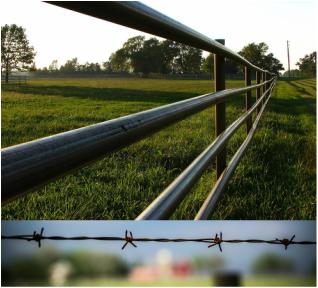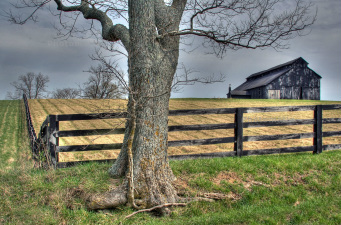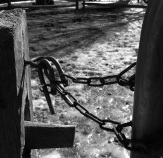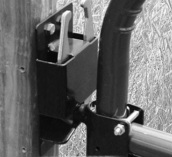Turnout Areas
Horses have evolved to live on wide-open plains or mountainsides (aside from the draft breeds which adapted to a marshy environment), roaming many miles in a day. Their stomachs are designed to be grazing 12-16 hours a day (Christie, 2008) and therefore do best when continuously digesting small portions of food (Cooper et al., 2005). Turnout is essential for a horse's mental and physical health. Time spent outdoors, especially grazing, has been show to significantly reduce both health issues and behavioral problems. A turnout area should, at the minimum, have enough room for the horse to trot and turn but ideally enough for multiple horses to be turned out together and able to run/play. Many studies have been done to determine the minimum amount of land necessary to sustain one grazing horse. While results varied depending on the soil and crop (which determine how quickly the grass grows and recovers), it is suggested that each horse have at least 1 1/2 to 2 acres of open land.
|
Arguments against it:
|
Turnout areas consist of pens, runs, corrals and paddocks. Pens are usually the size of a large stall while runs are longer (16' by 20') and often times attached to shelters, creating a "run-in stall". A corral or paddock refers to an even larger square or round pen, but likely still devoid of grass. A paddock is a grassy area used for grazing, ranging from half an acre to many acres in size and is generally used sparingly so as to preserve the grass. Sometimes the terms paddock and pasture are used interchangeably, but usually a pasture refers to a larger and lusher turn-out area that is used more often or even continuously. Mud and holes are common problems with pens and runs, due to their lack of living ground cover. Therefore, proper footing is very important.
Footing
It's important to maintain good footing in turn-out areas, for both the safety and health of your horse.
Mud Control: Excessive exposure to wet conditions can lead to many hoof and skin problems, such as thrush or scratches. First off, install some form of roof drainage (a gutter system or French drain beneath the eves) to prevent water coming off the roof from flooding the pens. Carving a small trench through the paddocks will also help drain puddles. In addition, laying down sand, stone-dust, or gravel, can help prevent flooding.
Preventing Ruts and Holes: Ruts and holes encourage flooding and can trip and injure a horse or person. High-traffic areas can be reinforced with plastic grids, installed beneath some sand or gravel. Rubber mats can also be buried to prevent holes from forming. However, be aware that they can become slippery when wet and should be fully covered. Strategically placed obstacles (such as a large rock, tire, railroad ties, or water tubs) can also go a long way as far as discouraging pawing and redirecting traffic.
Mud Control: Excessive exposure to wet conditions can lead to many hoof and skin problems, such as thrush or scratches. First off, install some form of roof drainage (a gutter system or French drain beneath the eves) to prevent water coming off the roof from flooding the pens. Carving a small trench through the paddocks will also help drain puddles. In addition, laying down sand, stone-dust, or gravel, can help prevent flooding.
Preventing Ruts and Holes: Ruts and holes encourage flooding and can trip and injure a horse or person. High-traffic areas can be reinforced with plastic grids, installed beneath some sand or gravel. Rubber mats can also be buried to prevent holes from forming. However, be aware that they can become slippery when wet and should be fully covered. Strategically placed obstacles (such as a large rock, tire, railroad ties, or water tubs) can also go a long way as far as discouraging pawing and redirecting traffic.
Fencing
Wood is the most popular fencing material because it is the most aesthetically pleasing, strong, and has high visibility. That being said, the initial cost of wood fencing can be relatively high and wood decays easily. As a result, wood is one of the hardest fencing types to maintain. Therefore, it is important to use pressure treated posts, boards, and rails or naturally decay-resistant woods such as red cedar, cypress or black locust [2]. Treated wood of any type should not come into direct contact with feed because the chemical preservatives used in it can be toxic to horses. It is also not advised for use indoors where a horse is more likely to crib and weather-resistant materials are not needed anyways. If building a wooden fence, it is important that the boards be nailed on the inside of a pen. At least three boards should be used, with the lowest one placed about a foot off the ground and the top board at the horse's eye level. A solid barrier can also be created with wood, which could be advantageous for stallion enclosures or training areas.
Metal is also often used for fencing, specifically steel due to its strength and durability. It is important that steel, regardless as to whether it's being used for posts and rains or nail and staples, should be galvanized to prevent rust from developing. Steel's use in fencing can be seen in manufactured and portable panels, self-made permanent pens, and galvanized wire. Portable panels are the most commonly used metal fencing because they are easy to move and change. They come in a variety of heights and can be easily attached to others to create any size enclosure. Be careful when turning out young or rambunctious horses, as hooves and small heads can easily get stuck between bars. Permanent steel pens are usually made by setting galvanized steel pipe into cement and then welding in pipe rails. This type of fencing is incredibly durable and rarely requires any maintenance after installation. However, they can be quite expensive to instal and risk injuring a horse because of their rigidity.
Metal is also often used for fencing, specifically steel due to its strength and durability. It is important that steel, regardless as to whether it's being used for posts and rains or nail and staples, should be galvanized to prevent rust from developing. Steel's use in fencing can be seen in manufactured and portable panels, self-made permanent pens, and galvanized wire. Portable panels are the most commonly used metal fencing because they are easy to move and change. They come in a variety of heights and can be easily attached to others to create any size enclosure. Be careful when turning out young or rambunctious horses, as hooves and small heads can easily get stuck between bars. Permanent steel pens are usually made by setting galvanized steel pipe into cement and then welding in pipe rails. This type of fencing is incredibly durable and rarely requires any maintenance after installation. However, they can be quite expensive to instal and risk injuring a horse because of their rigidity.
|
Steel panels, when lined up in a long straight line, are unstable and prone to leaning. Creating angles with each panel, as opposed to a straight line, can help stabilize them.
|
High-tensile-strength wire can be strung up between posts and electrified so as to deliver a mild shock when touched. This "electric fencing" is very affordable and can be used temporarily, permanently, or to divide other types of fenced in enclosures (to separate horses or enable pasture rotation). If used as a permanent fencing, consider choosing another material for a property/perimeter fence. That way if a horse were to spook and break through the electric line, they wouldn't proceed to run away or into heavy traffic. When selecting a wire type, take visibility, durability and function into account. For example, galvanized wire is a great conductor and therefore good for very large enclosure relying on one electric source. However, unless coated in plastic or dressed with colorful tapes, this wire is very hard to see and a horse may run right through it as a result. Polymer tape is adequate for most pens or paddocks and is usually more visible and therefore more respected by horses due to its increased width. Metal t-posts with plastic insulators are usually used for this set-up because they are easier to set in the ground than wood and relatively cheap. If you use metal posts, make sure to put plastic caps on each to prevent injury and be away that the plastic insulators tend to break easily when under strain. However, if you're using wooden posts, it is important to ground the electric wire periodically throughout the fenced-in area for safety during thunderstorms.
Wire mesh can be tacked between posts instead of traditional rails to provide a solid and visible barrier. Using woven wire is cheaper than wood and requires less maintenance but is generally not as strong and horses can get their hooves stuck in the rectangles. However V-mesh wire addresses these issues and is considered one of the safest fencing types, but is more expensive and harder to find. Sometimes facilities also use concrete and plastic to build fences. These are less common materials though, due to their many disadvantages. While concrete can be useful for securing other types of posts to the ground, it can be incredibly expensive if creating a whole wall. Plastic can become brittle easily in cold weather and soft in extreme heat. If using this type of fencing, make sure to select farm quality plastic or else it will likely be too thin and weak to contain a horse.
Wire mesh can be tacked between posts instead of traditional rails to provide a solid and visible barrier. Using woven wire is cheaper than wood and requires less maintenance but is generally not as strong and horses can get their hooves stuck in the rectangles. However V-mesh wire addresses these issues and is considered one of the safest fencing types, but is more expensive and harder to find. Sometimes facilities also use concrete and plastic to build fences. These are less common materials though, due to their many disadvantages. While concrete can be useful for securing other types of posts to the ground, it can be incredibly expensive if creating a whole wall. Plastic can become brittle easily in cold weather and soft in extreme heat. If using this type of fencing, make sure to select farm quality plastic or else it will likely be too thin and weak to contain a horse.
Latches
Gate latches must be impossible for a horse to open but easy for a person to. Ideally, they can also be opened using only one hand or while wearing winter gloves. Some of the most common ones used include:







